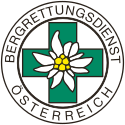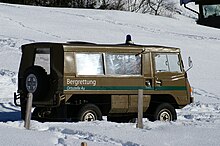Austrian mountain rescue service
| Austrian Mountain Rescue Service Federal Association | |
|---|---|

|
|
| legal form |
Association ( ZVR : 485547644) |
| Seat | Schelleingasse 26/2/2, 1040 Vienna |
| people | Stefan Hochstaffl (President) |
| Website | bergrettung.at |
The Austrian Mountain Rescue Service is a charity that in Austria the mountain rescue service performs. Mountain rescue in Austria is divided into seven national organizations. Both the Austrian as a whole and the regional associations are organized as individual associations.
The standardized mountain rescue emergency call (Alpine emergency call) can be reached in Austria on the telephone number 140. This leads to the responsible rescue control center. If there is no reception from your own network provider, 112, the Euro emergency call , should be dialed, as this does not call a telephone number, but rather triggers the emergency call function of the GSM standard. The subscriber is connected to the responsible emergency call point, which is defined in the GSM base station. Emergency calls via 112 are answered by the police in Austria. In order to make an emergency call via a mobile phone, the availability of the network of at least one network provider is necessary. The use of SMS and low-disruption night time can be helpful when the network connection is poor and for economical use of the remaining battery charge.
history
An avalanche accident on the Reissthalersteig on the Styrian side of the Rax on March 8, 1896 , in which three well-known Viennese mountaineers (Josef Pfannl, Max Schottik and Fritz Wannieck) were buried and only after a search for days is seen as the triggering event for the establishment of the first alpine rescue organization could be recovered dead. The accident caused such a stir that on April 24, 1896, the Austrian Alpine Club in Vienna organized a discussion evening on the question of organizing a mountain rescue service. At the same time it was recognized that this idea could only be realized through joint action by the large alpine clubs.
On May 11, 1896, the delegates of the Austrian Alpine Club , the Alpine Society “Ennsthaler”, the “Austria” section and the academic section of the DÖAV , the Lower Austrian Mountain Association (today's ÖGV ) and the Austrian Tourist Club agreed “… that in Vienna A central office is to be created by the Alpine Corporations, which would have to intervene in the event of Alpine accidents ... "
The name “Alpine Rescue Committee Vienna” (ARAW) was specified in the subsequent registration as a club. This is considered to be the world's first organized mountain rescue service, as a model for similar organizations elsewhere and as a forerunner of today's Austrian mountain rescue service.
Heinrich Krempel was elected as the first director .
In the following years, further alpine rescue organizations were founded in the Eastern Alps :
- Alpine Rescue Society Innsbruck (1898)
- Alpine Rescue Committee Munich (1898)
- Alpine Rescue Committee Salzburg (1901)
- Alpine Rescue Committee Graz (1902)
When Austria was annexed in 1938, the rescue organizations became part of the German Mountain Rescue Service .
In 1939, the mountain rescue service was also given responsibility for nature conservation. In the further course of the Second World War , the mountain guards were sworn in as auxiliary police. In 1944 the mountain rescue service was placed under military positions.
After the Second World War, the Austrian Mountain Rescue Service (ÖBRD) was founded in 1946. The former rescue centers were merged into local offices.
The first avalanche dogs were with the Austrian mountain rescue service after the Second World War. In Tyrol there were already three dogs in the disaster winter 1950/1951, while in Salzburg only the first dog passed its test in 1954 (in Tyrol). In Upper Austria, the first dogs and dog handlers were not trained until 1974 at the Dümlerhütte for Upper Austria to search for victims in avalanches.
Since the mid / late 1990s, women have also been admitted to the mountain rescue service. (In the last federal state - Tyrol - the admission of women to the mountain rescue service was particularly fraught with conflict.) At the beginning of 2013 there were around 12,300 members, 473 women. The largest proportion of women is in Lower Austria / Vienna with around 7.5%, followed by Vorarlberg with 5.9%, Styria with 4.1%, Carinthia with 3.45%, Salzburg with 2.95%, Tyrol with 2, 81% and Upper Austria with 2.15%. In a comparison of the federal states, Tyrol has the most women in absolute numbers with 123. There was also the first local branch manager in Steinach am Brenner .
In Vorarlberg, mountain rescue has been commissioned by the state of Vorarlberg to organize and operate air rescue. For the provision of the aircraft and the pilots, corresponding contracts were concluded with the Christophorus Air Rescue Association (Christophorus 8) and with the Wucher company (Gallus 1).
In 1952 the Austrian Mountain Rescue Service was one of the winners of the Karl Renner Prize .
Areas of responsibility
The area of responsibility mainly includes the rescue of injured people from rough terrain. An exact definition of this area is difficult, but it can be said in a simplified way that mountain rescue intervenes where the fire brigade, Red Cross, etc. are no longer able to help due to their equipment and geographic conditions. The mountain rescue also carries out searches for missing people in any terrain. This is often done with the support of local fire service associations and similar rescue organizations.
In the event of an alpine accident, the task force always lies with the mountain rescue team during the rescue operation. Exceptions are major events and catastrophes, where a special task force is formed, as well as rescue operations in which the mountain rescue service provides assistance (e.g. car accident in sloping terrain) for another rescue organization.
Preventive measures and prevention
For a number of years, mountain rescue has also been running its own preventive program to avoid accidents and to provide information about inexpensive rescue insurance as part of a sponsorship program. This program was mainly driven by the Tyrolean regional management; all seven regional management are now involved.
Organization and operations
In Austria there are around 300 local offices with around 12,000 voluntary mountain rescuers.
Around 7,000 missions in the mountains are handled by all local offices each year. About 60% of the missions are on the ski slopes. The second larger area is in the rest of the alpine area, such as hiking trails, alpine pastures, crags, gullies and gorges or forests and meadows. However, only a small part is accounted for by the most dangerous missions, such as 2% in rock or 1% in ice.
National organizations
- Provincial management for Lower Austria and Vienna
It is divided into the three areas south, west and center and includes around 30 local offices with 1300 members.
- Regional management Salzburg
- Provincial Head of Styria
- Provincial management of Upper Austria
- Provincial Head of Carinthia
- Regional management of Tyrol
- Vorarlberg regional management
The areas of the state lines coincide with the state borders. The regional management of Lower Austria / Vienna is responsible for the two federal states of Vienna and Lower Austria. There is no regional management for Burgenland.
federal Association
Reinhold Dörflinger was President of the Federal Association from 1996 to 2010 and Colonel Franz Lindenberg from 2010 to 2017, and Stefan Hochstaffel since November 2017. Martin Gurdet has been managing director of the federal association since February 2015.
Web links
Individual evidence
- ^ Bundesverband ÖBRD> The Presidium. Retrieved January 13, 2020 .
- ↑ Five days in a crevice: injured German out of danger to life. DiePresse.com, November 9, 2017, accessed November 18, 2017.
- ↑ Wolfgang Ladenbauer: The mountain rescue, the oldest alpine rescue organization in the world. In: Der Gebirgsfreund vol. 117, 2006.
- ↑ Salzburg Mountain Rescue Dogs , accessed on November 7, 2010.
- ↑ Avalanche dogs , accessed October 7, 2010.
- ↑ Mountain rescue recruits women. In: tirol.orf.at. March 22, 2013. Retrieved March 22, 2013 .
- ↑ Vienna City Hall Correspondence, December 10, 1952, sheet 1937
- ↑ Vienna City Hall Correspondence, December 13, 1952, sheet 1966
- ^ Tirol WHITE Edition ( memento from January 3rd, 2011 in the Internet Archive ), avalanche equipment package from the Tyrolean Mountain Rescue Service
- ↑ Funding information from the Austrian mountain rescue service ( memento of the original from January 3, 2011 in the Internet Archive ) Info: The archive link has been inserted automatically and has not yet been checked. Please check the original and archive link according to the instructions and then remove this notice.
- ↑ Page no longer available , search in web archives: Der Gebirgsfreund Jg. 117 (2006) (PDF; 194 kB), guest commentary by Wolfgang Ladenbauer, doctor and member of the ÖBRD in Puchberg am Schneeberg
- ↑ BrandAus, magazine of the nö. Fire brigades 9/2013.
- ^ Mountain rescue Carinthia: High distinction for ÖBRD President Dörflinger from the Federal President . Retrieved March 17, 2019.
- ↑ Mountain rescue: Lindenberg replaces Dörflinger . Article dated October 3, 2010, accessed March 17, 2019.
- ^ The Federal Association of the Austrian Mountain Rescue Service. In: Organization. On Bergrettung.at, accessed on January 20, 2019.
- ^ Federal Association Conference of the Austrian Mountain Rescue Service . Article dated November 5, 2017, accessed November 7, 2017.
- ↑ Bergrettung.at - President Colonel Franz Lindenberg ( Memento of the original from February 18, 2015 in the Internet Archive ) Info: The archive link was inserted automatically and has not yet been checked. Please check the original and archive link according to the instructions and then remove this notice. . Retrieved February 18, 2015.
- ↑ Bergrettung.at - Lindenberg new President of the ÖBRD ( Memento of the original from February 18, 2015 in the Internet Archive ) Info: The archive link was inserted automatically and has not yet been checked. Please check the original and archive link according to the instructions and then remove this notice. . Article dated October 3, 2010, accessed February 18, 2015.
- ↑ New federal manager for the ÖBRD ( Memento from February 17, 2015 in the Internet Archive )
- ↑ Austrian Mountain Rescue Service: Federal Association Presidium ( Memento of the original from February 17, 2015 in the Internet Archive ) Info: The archive link was inserted automatically and has not yet been checked. Please check the original and archive link according to the instructions and then remove this notice. . Retrieved February 18, 2015.
- ↑ NÖN: Martin Gurdet is managing director of the mountain rescue . Article dated February 19, 2015, accessed February 18, 2015.


